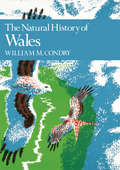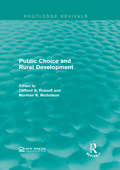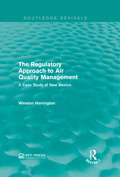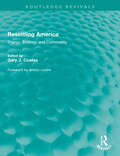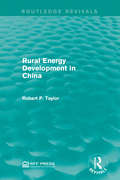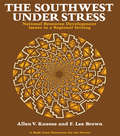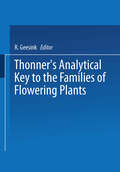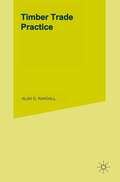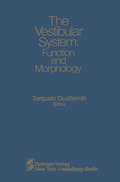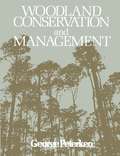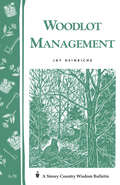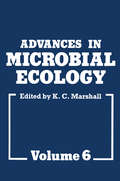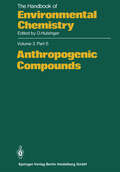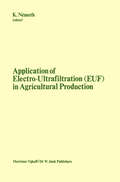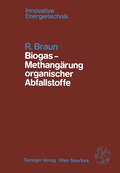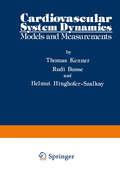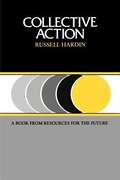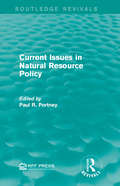- Table View
- List View
The Natural History of Wales (Collins New Naturalist Library #66)
by William. M. CondryThis book is an attempt to survey the natural history of the whole of Wales. It therefore covers such areas as Snowdonia and the Brecon Beacons as well as the spectacularly beautiful Pembrokeshire coast and the less well-known but no less interesting areas of mid-Wales.
Poems of Thomas Hardy: A New Selection (Macmillan Collector's Library #90)
by Thomas HardyThomas Hardy saw himself, first and foremost, as a poet, and he wrote poetry throughout his prolific and acclaimed novel-writing years before announcing in 1896 that he would no longer write novels, much to the astonishment of his worldwide readership. Instead he went on to publish eight masterful volumes of poetry - ranging from lyrics and ballads to dramatic monologues and satire - and is now regarded as one of the greatest twentieth-century poets.Choosing the best verse from each volume, the Poems of Thomas Hardy is the perfect introduction to Hardy's lyrical, soul-searching and profoundly sincere poetry, covering subjects ranging from his grief at the death of his first wife to his experiences of war.This beautiful Macmillan Collector's Library edition is edited and introduced by editor Ned Halley.Designed to appeal to the booklover, the Macmillan Collector's Library is a series of beautiful gift editions of much loved classic titles. Macmillan Collector's Library are books to love and treasure.
Public Choice and Rural Development (Routledge Revivals)
by Clifford S. Russell Norman K. NicholsonThis title, originally published in 1981, explores the difficult, and at times volatile, relationship between public choice and rural development in developing countries. The book is organised into three major sections: the first section examines important general themes, the second describes how public choice and rural development intertwine in some areas of concern to aid donors, and finally, the third section revisits the major themes discussed in the book and offers further understanding to the critical questions and problems at hand. It is a valuable resource for students interested in environmental studies and development studies.
Public Choice and Rural Development (Routledge Revivals)
by Clifford S. Russell Norman K. NicholsonThis title, originally published in 1981, explores the difficult, and at times volatile, relationship between public choice and rural development in developing countries. The book is organised into three major sections: the first section examines important general themes, the second describes how public choice and rural development intertwine in some areas of concern to aid donors, and finally, the third section revisits the major themes discussed in the book and offers further understanding to the critical questions and problems at hand. It is a valuable resource for students interested in environmental studies and development studies.
The Regulatory Approach to Air Quality Management: A Case Study of New Mexico (Routledge Revivals)
by Winston HarringtonIn the wake of the Clean Air Amendments of 1970 in the United States, sources of emissions could be held accountable for the degradation of air quality in the local environment. This case study of air quality management in New Mexico was produced to shed some light on the procedures and activities used by agencies in order to control air quality. Originally published in 1981, Winston Harrington uses New Mexico as a case study for its largely centralised control system in Santa Fe to explore the behaviour of air quality agencies and pollution sources and comments on policy implications from this study’s conclusions. This title will be of interest to students of environmental studies and policy makers.
The Regulatory Approach to Air Quality Management: A Case Study of New Mexico (Routledge Revivals)
by Winston HarringtonIn the wake of the Clean Air Amendments of 1970 in the United States, sources of emissions could be held accountable for the degradation of air quality in the local environment. This case study of air quality management in New Mexico was produced to shed some light on the procedures and activities used by agencies in order to control air quality. Originally published in 1981, Winston Harrington uses New Mexico as a case study for its largely centralised control system in Santa Fe to explore the behaviour of air quality agencies and pollution sources and comments on policy implications from this study’s conclusions. This title will be of interest to students of environmental studies and policy makers.
Resettling America: Energy, Ecology and Community (Routledge Revivals)
Every movement has its bellweathers, the ideas that lead the way and rally its adherents towards a set of shared values and visions. Resettling America was one such beacon – a publication for its time and ahead of its time. Those of us doing the work of sustainability and the transformation of communities feel grateful for Gary’s early and prescient contribution that has shaped the thinking of so many around the US and beyond. Essential reading for all green warriors! Jason F. McLennan, Chief Sustainability Officer – Perkins & Will. Founder, Living Building Challenge. Originally published in 1981 and now reissued with a new Preface by Gary J. Coates, Resettling America was one of the first comprehensive, transdisciplinary books on the crisis of sustainability and the implications of that crisis for the re-design of buildings, towns, cities and regions. Through essays by Coates, which provide a theory of ecological design, and case studies written by leading authors and activists of the time, the book presents a strategic vision of how it would be possible to create a sustainable and livable society through a process of cooperative community development rooted in a radical re-visioning of nature, self and society. By providing a strategic vision, as well offering practical means for creating a sustainable society worth sustaining, Resettling America remains more relevant and inspiring than ever to those who face the ecology of crises that now surround us in the 21st Century.
Resettling America: Energy, Ecology and Community (Routledge Revivals)
by Gary J. CoatesEvery movement has its bellweathers, the ideas that lead the way and rally its adherents towards a set of shared values and visions. Resettling America was one such beacon – a publication for its time and ahead of its time. Those of us doing the work of sustainability and the transformation of communities feel grateful for Gary’s early and prescient contribution that has shaped the thinking of so many around the US and beyond. Essential reading for all green warriors! Jason F. McLennan, Chief Sustainability Officer – Perkins & Will. Founder, Living Building Challenge. Originally published in 1981 and now reissued with a new Preface by Gary J. Coates, Resettling America was one of the first comprehensive, transdisciplinary books on the crisis of sustainability and the implications of that crisis for the re-design of buildings, towns, cities and regions. Through essays by Coates, which provide a theory of ecological design, and case studies written by leading authors and activists of the time, the book presents a strategic vision of how it would be possible to create a sustainable and livable society through a process of cooperative community development rooted in a radical re-visioning of nature, self and society. By providing a strategic vision, as well offering practical means for creating a sustainable society worth sustaining, Resettling America remains more relevant and inspiring than ever to those who face the ecology of crises that now surround us in the 21st Century.
Rural Energy Development in China (Routledge Revivals)
by Robert P. TaylorIn this title, originally published in 1981, author Robert P. Taylor calls for a greater understanding of rural energy supply and consumption patterns in the developing countries. Here, Taylor specifically examines the rural energy development in China as it is the world’s largest developing country in terms of population, and it has encountered many of the rural energy problems common in other developing countries. This study provides an analysis of China’s rural energy economy from before 1949 to a general discussion of achievements in rural energy development and the rural energy economy in 1981. This is an ideal title for students interested in environmental studies and development studies.
Rural Energy Development in China (Routledge Revivals)
by Robert P. TaylorIn this title, originally published in 1981, author Robert P. Taylor calls for a greater understanding of rural energy supply and consumption patterns in the developing countries. Here, Taylor specifically examines the rural energy development in China as it is the world’s largest developing country in terms of population, and it has encountered many of the rural energy problems common in other developing countries. This study provides an analysis of China’s rural energy economy from before 1949 to a general discussion of achievements in rural energy development and the rural energy economy in 1981. This is an ideal title for students interested in environmental studies and development studies.
The Southwest Under Stress: National Resource Development Issues in a Regional Setting
by Allen V. Kneese F. Lee BrownSouthwest Under Stress examines the development-environment conflict in the four contiguous states of Arizona, Utah, Colorado, and New Mexico. It emphasizes three issues with implications that extend far beyond the Southwest: water---its quantity, quality, and allocation; environment---how and to what extent it should be preserved; and the future of Native American and other poverty-stricken peoples. Energy comes in for special attention because the Southwest is a principal repository of fossil and nuclear fuels. This book serves as a guide for public policy in the region, and many of the policy alternatives set out are aimed at state and local governments. Alleviating poverty, improving the lot of Native Americans, and formulating workable water, environmental, and natural resources development policies are all of special concern to the region, but the federal government has asserted a dominant role in may of these areas. The book discusses ways in which the federal role may change to improve both federal policy itself and cooperation with other levels of government.
The Southwest Under Stress: National Resource Development Issues in a Regional Setting
by Allen V. Kneese F. Lee BrownSouthwest Under Stress examines the development-environment conflict in the four contiguous states of Arizona, Utah, Colorado, and New Mexico. It emphasizes three issues with implications that extend far beyond the Southwest: water---its quantity, quality, and allocation; environment---how and to what extent it should be preserved; and the future of Native American and other poverty-stricken peoples. Energy comes in for special attention because the Southwest is a principal repository of fossil and nuclear fuels. This book serves as a guide for public policy in the region, and many of the policy alternatives set out are aimed at state and local governments. Alleviating poverty, improving the lot of Native Americans, and formulating workable water, environmental, and natural resources development policies are all of special concern to the region, but the federal government has asserted a dominant role in may of these areas. The book discusses ways in which the federal role may change to improve both federal policy itself and cooperation with other levels of government.
Thonner’s analytical key to the families of flowering plants (Leiden Botanical Series #5)
by R. GeesinkThe Vestibular System: Function and Morphology
by T. GualtierottiVestibular physiology has acquired new interest in the past few years. The development of fast aircraft, beginning during the Second World War and continuing through modern supersonic jets and space travel, has increased dramatically the acceleration range to which man is subjected, from prolonged weightlessness to several gs. The labyrinth measures all kinds of acceleration, including gravity. and therefore has taken on particular impor tance in the study of human health in the Space Age. It is understandable. then, that NASA sponsored the Symposium on Vestibular Function and Morphology. a satellite of the Eighth Annual Meeting of the Society of Neuroscience. held October 30-November 1. 1978, at the University of Pittsburgh, which also supported the symposium. The present volume was developed from papers originally presented there. My strategy in editing this book has been to focus upon the vestibular end organ and its direct connections. both peripheral and central, in order to as sure a coherent discussion of the basics of vestibular function, structure, and ultrastructure. Fortunately, it was possible to secure the contributions of a number of outstanding investigators from both the United States and abroad, including functionally oriented morphologists. ultrastructuralists, biophysicists, and vestibular physiologists. The result is a comprehensive discussion of the main mechanisms of the labyrinth: the transduction pro cess at the receptor level, in the semicircular canals, and in the utricular and saccular maculae; the information transfer through neuronal pathways to the nuclei and the cerebellum; and the general organization of the system.
Woodland Conservation and Management
by G. F. PeterkenProfessor John Harper, in his recent Population Biology of Plants (1977), made a comment and asked a question which effectively states the theme of this book. Noting that 'one of the consequences of the development of the theory of vegetational climax has been to guide the observer's mind forwards', i. e. that 'vegetation is interpreted asa stage on the way to something', he commented that 'it might be more healthy and scientifically more sound to look more often backwards and search for the explanation of the present in the past, to explain systems in relation to their history rather than their goal'. He went on to contrast the 'disaster theory' of plant succession, which holds that communities are a response to the effects of past disasters, with the 'climax theory', that they are stages in the approach to a climax state, and then asked 'do we account most completely for the characteristics of a population by a knowledge of its history or of its destiny?' Had this question been put to R. S. Adamson, E. J. Salisbury, A. G. Tansley or A. S. Watt, who are amongst the giants of the first forty years of woodland ecology in Britain, their answer would surely have been that understanding lies in a knowledge of destiny. Whilst not unaware of the historical facts of British woodlands, they were preoccupied with ideas of natural succession and climax, and tended to interpret their observations in these terms.
Woodlot Management: Storey's Country Wisdom Bulletin A-70 (Storey Country Wisdom Bulletin)
by Jay HeinrichSince 1973, Storey's Country Wisdom Bulletins have offered practical, hands-on instructions designed to help readers master dozens of country living skills quickly and easily. There are now more than 170 titles in this series, and their remarkable popularity reflects the common desire of country and city dwellers alike to cultivate personal independence in everyday life.
Advances in Microbial Ecology: Volume 6 (Advances in Microbial Ecology #6)
by K. C. MarshallThis volume of Advances in Microbial Ecology marks a change in the editor ship of the series. The Editorial Board wishes to take this opportunity to express its gratitude to Martin Alexander, the founding editor and editor of the first five volumes, for his enterprise in establishing the series and in ensuring that Advances has become an outstanding focal point for the identification of new developments in the rapidly expanding field of microbial ecology. With the publication of this volume, we welcome Howard Slater to the Editorial Board. The policies of the Editorial Board remain the same as before. Most con tributions to Advances in Microbial Ecology will be solicited by the Board. However, individuals are encouraged to submit outlines of unsolicited contri butions to the Board for consideration for inclusion in the series. Advances is designed to serve an international audience and to provide critical reviews on basic and applied aspects of microbial ecology. Contributions in the present volume are predominantly concerned with the ecology of aquatic microorganisms, but encompass a variety of approaches to this area. The exception is the chapter by J. W. Doran on the role of micro organisms in the cycling of selenium. G-Y. Rhee discusses the effects of envi ronmental factors on phytoplankton growth. The factors limiting the produc tivity of freshwater microbial ecosystems are considered by H. W. Paerl.
Anthropogenic Compounds (The Handbook of Environmental Chemistry #3 / 3B)
by K. J. Bock K. A. Daum E. Merian L. W. Newland C. R. Pearson H. Stache M. ZanderEnvironmental Chemistry is a relatively young science. Interest in this subject, however, is growing very rapidly and, although no agreement has been reached as yet about the exact content and limits of this interdisciplinary discipline, there appears to be increasing interest in seeing environmental topics which are based on chemistry embodied in this subject. One of the first objectives of Environmental Chemistry must be the study of the environment and of natural chemical processes which occur in the environment. A major purpose of this series on Environmental Chemistry, therefore, is to present a reasonably uniform view of various aspects of the chemistry of the environment and chemical reactions occurring in the environment. The industrial activities of man have given a new dimension to Environmental Chemistry. We have now synthesized and described over five million chemical compounds and chemical industry produces about hundred and fifty million tons of synthetic chemicals annually. We ship billions of tons of oil per year and through mining operations and other geophysical modifications, large quantities of inorganic and organic materials are released from their natural deposits. Cities and metropolitan areas of up to 15 million inhabitants produce large quantities of waste in relatively small and confined areas. Much of the chemical products and waste products of modern society are released into the environment either during production, storage, transport, use or ultimate disposal. These released materials participate in natural cycles and reactions and frequently lead to interference and disturbance of natural systems.
Application of Electro-Ultrafiltration (EUF) in Agricultural Production: Proceedings of the First International Symposium on the Application of Electro-Ultrafiltration in Agricultural Production, organized by the Hungarian Ministry of Agriculture and the Central Research Institute for Chemistry of the Hungarian Academy of Sciences, Budapest, May 610, 1980
by K. NémethThe Symposium was organized by the Hungarian Ministry of Agriculture and the Central Research Institute for Chemistry of the Hungarian Academy of Sciences. This arduous task was coordinated by Dr. Varju to whom I wish to express my appreciation for his whole-hearted assistance. After the Symposium the participants had the opportunity to visit the vineyards and cellars of the 'Balatonboglar' state holding which proved of great interest. The First International EUF Symposium owes its success to the excellent cooperation between the Biintehof Agricultural Research Station and the Hungarian Ministry of Agriculture, including the Central Research Institute for Chemistry of the Hungarian Academy of Sciences. The objective of the Symposium was to present the first results and experience gained with the EUF procedure, so that the papers delivered are only a survey of the present-day state of knowledge. The bulk of the work of editing, including the selection of the articles, fell on Prof. Dr. van Diest, Wageningen, for whose valuable advice and untiring efforts I wish to record my special thanks. Some of the papers presented at the Symposium have already been published elsewhere and they will not appear in this issue.
Biogas — Methangärung organischer Abfallstoffe: Grundlagen und Anwendungsbeispiele (Innovative Energietechnik)
by R. BraunCollective Action
by Russell HardinPublic choice, an important subdiscipline in the field of political theory, seeks to understand how people and societies make decisions affecting their collective lives. Relying heavily on theoretical models of decision making, public choice postulates that people act in their individual interests in making collective decisions. As it happens, however, reality does not mirror theory, and people often act contrary to what the principal public choice models suggest. In this book, Russell Hardin looks beyond the models to find out why people choose to act together in situations that the models find quite hopeless. He uses three constructs of modern political economy--public goods, the Prisoner's Dilemma, and game theory--to test public choice theories against real world examples of collective action. These include movements important in American society in the past few decades--civil rights, the Vietnam War, women's rights, and environmental concerns. This classic work on public choice will be of interest to theoreticians and graduate students in the fields of public choice, political economy, or political theory--and to those in other disciplines who are concerned with the problem of collective action in social contexts.
Current Issues in Natural Resource Policy (Routledge Revivals)
by Paul R. PortneyThis volume offers an objective view of some of the most critical issues in natural resources. Written in nontechnical language, it uses ideas drawn from economics to look at the issues, examine how government laws and policies have caused some of them arise, and to find ways in which problems can be lessened. Originally published in 1982, this is a valuable resource for students interested in environmental studies and public policy.
Current Issues in Natural Resource Policy (Routledge Revivals)
by Paul R. PortneyThis volume offers an objective view of some of the most critical issues in natural resources. Written in nontechnical language, it uses ideas drawn from economics to look at the issues, examine how government laws and policies have caused some of them arise, and to find ways in which problems can be lessened. Originally published in 1982, this is a valuable resource for students interested in environmental studies and public policy.
